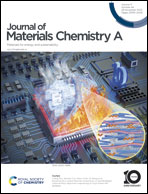Cathode interface materials based on perylene-diimide derivatives for thickness insensitivity and high fill factor heterojunction organic solar cells†
Abstract
Cathode interface layers are important to improve the performance of organic solar cells (OSCs). In this work, two perylene diimide (PDI) derivatives (2N-PDI and 2NBr-PDI) as cathode interface materials were reported. Studies of ultraviolet photoelectron spectroscopy (UPS), electron paramagnetic resonance (EPR), atomic force microscopy (AFM), electron mobility, and light intensity dependence were carried out. The results show that 2NBr-PDI has better metal electrode work function (WF) adjustability, film morphology, and electron mobility than PDINO. The device with 2NBr-PDI as the cathode interface layer with PM6:Y6 as the active layer reached a power conversion efficiency (PCE) of 16.18% and a high fill factor (FF) of 78.37%, which is one of the highest values among PM6:Y6 systems. Notably, it exhibits good thickness insensitivity, with PCE remaining at 90% at a thickness of 35 nm, which facilitates future large-scale production.



 Please wait while we load your content...
Please wait while we load your content...